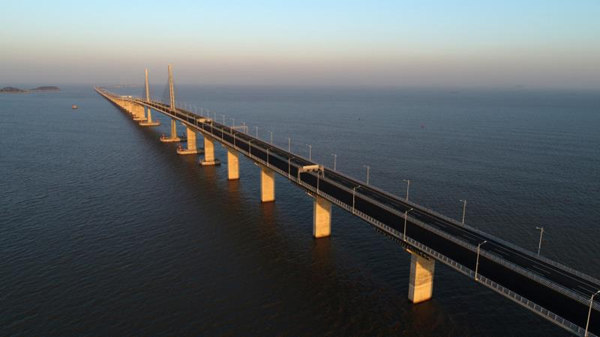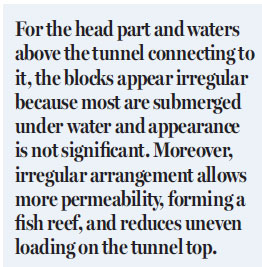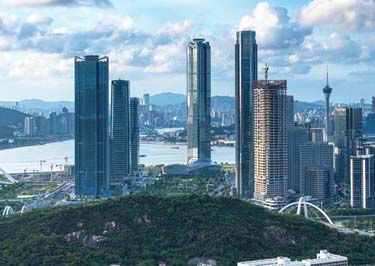Tunnel-bridge islands standing firm in sea

Hong Kong-Zhuhai-Macao spanning Lingding Sea [Photo by Li Jianshu]
Engineering and environmental considerations led designers to place dolosse at random, while the rest were regular, leading to media scare, Lin Wei writes
Editor's note: A major designer of the Hong Kong-Zhuhai-Macao Bridge explains the technical details of the bridge's artificial islands and refutes media accusations that their structures have been damaged.
The Hong Kong-Zhuhai-Macao Bridge features four artificial islands - two standing in the sea and two on the shore. Those in the sea were built by China Communications Construction on a construction and design contract.
The sea islands connect the bridge sections  which run above the water with the submarine tunnel. To achieve this link we invented the "deep-insert steel cylinders" technique to build the islands, ensuring the bridge could open for traffic according to schedule. This new technique piles 120 steel cylinders - 22 meters in diameter and more than 50 meters long - one by one 30 meters into the seabed. The innovation shortened construction time of the islands from three years to just seven months and let builders avoid large-scale seabed dredging, which protected the maritime ecosystem and diminished the bridge's impact on the Chinese white dolphins' habitat. This new technique is like planting trees in the sea, so the islands could be firmly rooted.
which run above the water with the submarine tunnel. To achieve this link we invented the "deep-insert steel cylinders" technique to build the islands, ensuring the bridge could open for traffic according to schedule. This new technique piles 120 steel cylinders - 22 meters in diameter and more than 50 meters long - one by one 30 meters into the seabed. The innovation shortened construction time of the islands from three years to just seven months and let builders avoid large-scale seabed dredging, which protected the maritime ecosystem and diminished the bridge's impact on the Chinese white dolphins' habitat. This new technique is like planting trees in the sea, so the islands could be firmly rooted.
The underwater tunnel is connected to an island at each end, its top elevation being above the surrounding seabed. To lower the risk of ship collisions we adopted the submerged breakwater design, with a 120-meter-wide breakwater protecting the tunnel. It is this submerged breakwater that has led to what Hong Kong media have claimed to be evidence of the islands having shifted and been damaged.
Blocks of armor protection surrounding the artificial islands and above the tunnel have to be stabilized in place and must not be moved by waves or currents. Taking into consideration possible adverse weather and sea conditions in this region within the next 120 years, we hired professional research units to create design standards. When considering the type of armor protection, we compared accropode, dolosse and rock. After confirming the initial plan, we hired research units again to conduct physical-model tests under wave attack to formulate the final plan. We used dolosse of five and eight tons respectively as the blocks of armor protection. The artificial island at nearby Hong Kong port is certainly not subject to the same intensity of wave impacts so blocks of just two tons are used there. The stability of dolosse depends not only on their weight but also on interlocking. Compared with other kinds of protection armor, the permeability of dolosse is the best. That is why the dolosse could form a very good fish reef and an excellent habitat for white dolphins. When the bridge is in operation, whether the protection blocks are in good condition could be judged by visual observation.
To minimize tunnel subsidence, we used a sand compaction pile of high replacement ratio to strengthen the soft soil in the foundation. Natural sea sand is used in the process, creating minimal impact on the environment. Furthermore, before putting the tunnel in place, 1.4 million tons of gravel were used as ballast to compact the foundation in advance. The weight was about 120 percent of the total weight of the tunnel when in operation in future. As expected, measurement figures show the current subsidence of the tunnel is controlled at the best level.
When building two islands and a tunnel in the sea, the best design should respect nature on one hand while maintaining safety, environmental protection and beauty on the other. The dolosse arrangement for instance could be either regular or irregular. For the two sides and tail of the island this arrangement is "regular" since most of the blocks appear above sea level; a regular pattern looks good. For the head part and waters above the tunnel connecting to it, the blocks appear irregular because most are submerged under water and appearance is not significant. Moreover, irregular arrangement allows more permeability, forming a fish reef, and reduces uneven loading on the tunnel top. Typhoon Hato's attack last year was the most severe test on the project as well as our seven years' work. Readers could compare photographs before and after the typhoon attack and I guarantee you they won't find any damage.
Hong Kong is an international city that has undertaken the world-renowned infrastructure projects of the Tsing Ma Bridge and the Stonecutters Bridge. During the 20 years after the special administrative region's return to the motherland, the Chinese mainland's engineering capabilities have made immense progress. This bridge - constructed with the cooperation of Hong Kong, Zhuhai and Macao - is the most challenging engineering project in the world so far. That we have been able to accomplish it within seven years is something all Chinese people should take pride in.







